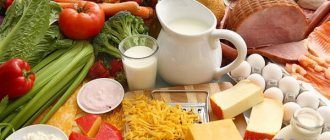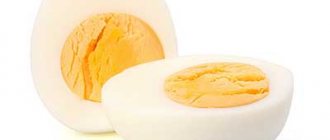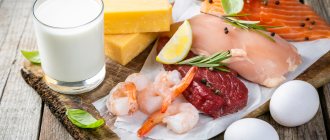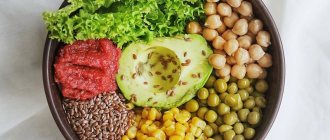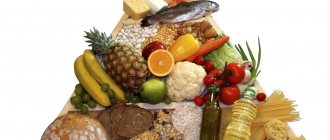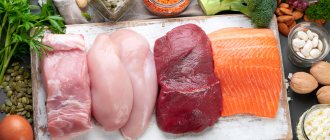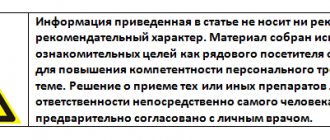Knowing the norm of protein, fat and carbohydrate consumption is necessary not only for those who carefully monitor their figure. This is also necessary for creating a balanced diet. After all, many people eat incorrectly, as a result of which they face various diseases. You can avoid some health problems by simply adjusting your diet. In addition, calculating the ratio of BJU in the diet and selecting the appropriate products is not as difficult as it seems.
- Squirrels
How to calculate calorie content and ratio of BZHU?
To find out your daily intake of proteins, fats and carbohydrates, you must first calculate your calorie content. This can be done using a calculator using the formula for calculating basal metabolic rate (BMR).
Calculation of ALE
The resulting number of calories indicates how much energy the body spends at rest. But in life a person moves, works, plays sports, etc. All this will increase the daily calorie consumption. Therefore, after calculating the basal metabolic rate, it is necessary to determine the activity coefficient (Ka). This can be done according to the following criteria:
| Ka | Description |
| 1,2 | No physical labor or minimal activity |
| 1,38 | Standard classes 3 days a week |
| 1,46 | Standard classes 5 days a week |
| 1,55 | Hard training 5 days a week |
| 1,64 | Daily workouts |
| 1,73 | Heavy daily training or training twice a day |
| 1,9 | Daily training and physically demanding work |
Now you can easily calculate your daily calorie intake (CD). To do this, you need to multiply the OOV value by the activity coefficient.
Sn = OOB x Ka
The resulting amount of calories is necessary to maintain weight.
For example, you can take a 25-year-old girl, 165 cm tall, weighing 50 kg, training 3 times a week. The basic metabolism for her will be equal to: 50 x 10 + (165 x 6.25) - (25 x 5) - 161 = 1245.25 kcal. Now this number needs to be multiplied by the activity coefficient of 1.38. The result will be 1718 kcal.
After calculating the calorie content, you need to determine the optimal ratio of proteins, fats and carbohydrates. This is required to improve the quality of the body, since without enough protein, the muscles will not receive sufficient nutrition and the skin will lose its elasticity. Carbohydrates are necessary to provide the body with energy, but their amount should not exceed the norm, otherwise excess fat deposits will form.
The correct ratio of BZHU to achieve a particular goal is shown in the figure.
When creating a menu, you should adhere to exactly this ratio.
There is a way to easily determine specific norms for protein, fat, and carbohydrate consumption per day. To do this, you need to know how many calories are in these macronutrients:
- 1 g protein - 4 kcal;
- 1 g fat - 9 kcal;
- 1 g of carbohydrates - 4 kcal.
Now you will need to calculate the shares of BZHU in the total daily calorie content. It’s worth returning to the example: a girl needs to consume 1718 kcal. The ratio of macronutrients for weight maintenance will be:
- proteins - 30%;
- fats - 25%;
- carbohydrates - 45%.
To calculate the protein norm, you will need to multiply 1718 kcal by 0.3 = 515.4 kcal. This value must be divided by 4 kcal, since this is the energy value of a gram of protein. The result will be 128 g. This is how many grams of protein the girl in the example needs to consume to maintain weight. You can also calculate the amount of fat (1718 x 0.25 = 429.5 kcal or 47 g) and carbohydrates (1718 x 0.45 = 773.1 kcal or 193 g).
So, the girl from the example needs to consume 128 g of protein, 47 g of fat and 193 g of carbohydrates per day to maintain her weight.
Cheese snacks
You can increase your protein intake in your diet with the right snacks. Cookies, buns, crackers, chips and other similar products are not the best option. They contain little protein. Their healthy and no less tasty analogue is cheese. It is lower in calories, rich in protein and calcium.
The highest protein cheeses are Parmesan cheese, Pecorino Romano, Gruyère and Swiss cheese.
Eating cheese during snacks not only saturates the body with the protein it needs, but also does not lead to an increase in cholesterol levels in the blood. The same cannot be said for oil-soaked chips. Your heart will be grateful for such a snack.
BJU consumption rate for different people
The table presents data that constitutes the values of daily calorie content and BJU norms, approximately calculated depending on body weight.
The table also takes into account the following activity groups:
- I - knowledge workers;
- II - work involving light physical labor;
- III - work involving moderate labor;
- IV - work associated with heavy physical labor;
- V - workers engaged in very heavy physical labor.
| Activity class | Weight | Women | Men | ||||||
| Calorie content, kcal | Proteins, g | Fats, g | Carbohydrates, g | Calorie content, kcal | Proteins, g | Fats, g | Carbohydrates, g | ||
| I | 40 kg | 1381 | 86 | 46 | 138 | 1581 | 99 | 61 | 158 |
| 50 kg | 1501 | 94 | 50 | 150 | 1700 | 106 | 66 | 170 | |
| 60 kg | 1621 | 122 | 54 | 162 | 1820 | 114 | 71 | 182 | |
| 70 kg | 1740 | 131 | 58 | 174 | 1940 | 121 | 75 | 194 | |
| 80 kg | 1861 | 140 | 62 | 186 | 2060 | 129 | 80 | 206 | |
| 90 kg | 1981 | 149 | 66 | 198 | 2180 | 136 | 85 | 218 | |
| 100 kg | 2101 | 158 | 70 | 210 | 2300 | 144 | 89 | 230 | |
| II | 40 kg | 1589 | 99 | 62 | 159 | 1818 | 114 | 71 | 182 |
| 50 kg | 1726 | 108 | 67 | 173 | 1955 | 122 | 76 | 196 | |
| 60 kg | 1864 | 117 | 72 | 186 | 2093 | 131 | 81 | 209 | |
| 70 kg | 2002 | 125 | 78 | 200 | 2231 | 139 | 87 | 223 | |
| 80 kg | 2139 | 134 | 83 | 214 | 2369 | 148 | 92 | 237 | |
| 90 kg | 2278 | 142 | 89 | 228 | 2507 | 157 | 97 | 251 | |
| 100 kg | 2416 | 151 | 94 | 242 | 2645 | 165 | 103 | 264 | |
| III | 40 kg | 1727 | 108 | 67 | 173 | 1976 | 123 | 77 | 198 |
| 50 kg | 1877 | 117 | 73 | 188 | 2126 | 133 | 83 | 213 | |
| 60 kg | 2026 | 127 | 79 | 203 | 2275 | 142 | 88 | 228 | |
| 70 kg | 2176 | 136 | 85 | 218 | 2425 | 152 | 94 | 243 | |
| 80 kg | 2326 | 145 | 90 | 233 | 2575 | 161 | 100 | 258 | |
| 90 kg | 2476 | 155 | 96 | 248 | 2725 | 170 | 106 | 272 | |
| 100 kg | 2626 | 164 | 102 | 263 | 2875 | 180 | 112 | 287 | |
| IV | 40 kg | 1957 | 122 | 76 | 196 | 2239 | 140 | 87 | 224 |
| 50 kg | 2127 | 133 | 83 | 213 | 2409 | 151 | 94 | 241 | |
| 60 kg | 2297 | 144 | 89 | 230 | 2579 | 161 | 100 | 258 | |
| 70 kg | 2466 | 154 | 96 | 247 | 2749 | 172 | 107 | 275 | |
| 80 kg | 2636 | 165 | 103 | 264 | 2918 | 182 | 113 | 292 | |
| 90 kg | 2806 | 175 | 109 | 281 | 3088 | 193 | 120 | 309 | |
| 100 kg | 2976 | 186 | 116 | 298 | 3258 | 204 | 127 | 325 | |
| V | 40 kg | 2187 | 137 | 85 | 219 | 2502 | 156 | 97 | 250 |
| 50 kg | 2377 | 149 | 92 | 238 | 2692 | 168 | 105 | 269 | |
| 60 kg | 2567 | 160 | 100 | 257 | 2882 | 180 | 112 | 288 | |
| 70 kg | 2757 | 172 | 107 | 276 | 3072 | 192 | 119 | 307 | |
| 80 kg | 2946 | 184 | 115 | 295 | 3262 | 204 | 127 | 326 | |
| 90 kg | 3136 | 196 | 122 | 314 | 3452 | 216 | 134 | 345 | |
| 100 kg | 3326 | 208 | 129 | 333 | 3641 | 228 | 142 | 364 | |
The values indicated in the table are very approximate, since height and age are averaged. In order to accurately calculate the daily calorie content and the ratio of BZHU, you need to independently make calculations using the above formula.
For weight loss
When losing weight, the caloric intake calculated to maintain weight will need to be adjusted. To do this, you need to determine the calorie corridor. The upper limit will be the calorie norm. To calculate the bottom, this number should be reduced by 15-20%.
You can't cut calories any further. This will cause your metabolism to slow down, making it much more difficult to lose weight.
The ratio of BZHU for losing excess weight, as already shown in the picture above, should be approximately this:
- proteins - 40-50%;
- fats - 30-40%;
- carbohydrates - 10-20%.
You can specifically determine the daily norms of macronutrients in grams by creating a menu, based on the calculated calorie content for weight loss. Products should be selected in such a way that the BJU ratio is maintained.
For gaining muscle mass
To grow muscles, your base caloric intake should be increased. You can add from 20 to 40% or even more to it.
But you shouldn’t dramatically increase your caloric intake. It is advisable to add 100-200 kcal daily.
The ratio of BZHU for muscle building should be approximately this:
- proteins - 25-35%;
- fats - 10-15%;
- carbohydrates - 40-60%.
This large amount of carbohydrates is needed to support the enormous energy expenditure of heavy weight training.
For children
The standards for consumption of BJU for children will be different. At a younger age, the ratio should be 1:1:3, at an older age - 1:1:4.
In addition, it is recommended to include more animal products in the child’s diet.
The table shows the daily value of calories and macronutrients for children of different ages.
| Age | Number of calories, kcal | Proteins, g | Fats, g | Carbohydrates, g |
| 1-1,5 | 1300 | 48 | 48 | 160 |
| 1,5-2 | 1500 | 53 | 53 | 192 |
| 3-4 | 1800 | 63 | 63 | 233 |
| 5-6 | 2000 | 72 | 72 | 252 |
| 7-10 | 2400 | 80 | 80 | 324 |
| 11-13 | 2850 | 96 | 96 | 382 |
| 14-17 (guys) | 3150 | 106 | 106 | 422 |
| 14-17 (girls) | 2750 | 93 | 93 | 367 |
It is advisable to at least approximately comply with these standards, since the child’s body is developing and needs nutrients to ensure growth.
Eggs for breakfast
Oatmeal contains more protein compared to all other cereals. One classic serving contains about 6 g of protein. However, if you compare oatmeal with eggs, it loses significantly. Thus, three chicken eggs contain 19 g of protein, as well as selenium and choline necessary for the body.
A number of studies have shown that eating eggs can reduce appetite and keep you feeling full longer. Therefore, a person does not overeat during dinner.
Eggs for breakfast are not only a way to fill your body with protein, but also a “cure” for fighting bad LDL cholesterol. Therefore, their consumption in food is a prevention of cardiovascular diseases [2], [3].
More details:
TOP protein-rich foods
Characteristics of BZHU and list of products
All that remains is to talk separately about proteins, fats and carbohydrates and figure out which products contain them. This is necessary to create a menu with the correct ratio of these macronutrients.
Squirrels
Proteins perform many functions in the human body: build new cells (including blood vessels, hair, muscles), carry oxygen to all tissues, strengthen the immune system, balance hormonal levels, etc.
The daily protein intake will depend on many factors: age, gender, weight, height, level of physical activity. On average, it is believed that a person needs about 1.5 g of protein per 1 kg of weight per day.
You can determine the exact number by calculating your body mass index (BMI):
BMI = weight (kg) / height² (m)
For example, for a girl weighing 60 kg and height 177 cm, BMI = 60 / 1.77² = 19.15.
Now you need to refer to the table, which shows the protein requirements per day (in grams) for women and men, depending on height and BMI.
| BMI | Height (cm) - women | Height (cm) - men | ||||||
| 147-153 | 154-163 | 164-173 | 174-183 | 154-163 | 164-173 | 174-183 | 184-193 | |
| 19 | 54 | 66 | 80 | 93 | 82 | 97 | 107 | 126 |
| 20 | 56 | 70 | 82 | 95 | 84 | 98 | 113 | 130 |
| 21 | 56 | 72 | 85 | 97 | 86 | 99 | 115 | 132 |
| 22 | 59 | 73 | 85 | 100 | 87 | 102 | 118 | 133 |
| 23 | 61 | 74 | 88 | 102 | 89 | 104 | 119 | 137 |
| 24 | 61 | 76 | 89 | 104 | 92 | 106 | 122 | 140 |
| 25 | 62 | 77 | 92 | 106 | 92 | 107 | 125 | 141 |
| 26 | 63 | 78 | 94 | 108 | 93 | 110 | 127 | 143 |
| 27 | 66 | 81 | 97 | 110 | 95 | 110 | 129 | 147 |
| 28 | 66 | 82 | 97 | 113 | 97 | 114 | 131 | 149 |
| 29 | 67 | 84 | 98 | 115 | 98 | 115 | 132 | 151 |
| 30 | 69 | 84 | 102 | 117 | 99 | 118 | 135 | 154 |
| 31 | 71 | 87 | 103 | 119 | 102 | 119 | 137 | 157 |
| 32 | 72 | 89 | 105 | 121 | 104 | 120 | 139 | 159 |
| 33 | 74 | 91 | 106 | 124 | 105 | 122 | 141 | 162 |
| 34 | 74 | 93 | 109 | 126 | 107 | 125 | 143 | 162 |
| 35 | 76 | 95 | 110 | 128 | 109 | 127 | 146 | 165 |
| 36 | 77 | 96 | 113 | 129 | 110 | 131 | 148 | 169 |
| 37 | 80 | 97 | 115 | 131 | 111 | 131 | 150 | 171 |
| 38 | 80 | 99 | 117 | 133 | 114 | 132 | 151 | 173 |
| 39 | 82 | 102 | 118 | 136 | 116 | 135 | 153 | 176 |
| 40 | 83 | 103 | 120 | 138 | 117 | 136 | 155 | 177 |
| 41 | 85 | 105 | 122 | 141 | 119 | 139 | 159 | 180 |
| 42 | 86 | 106 | 125 | 143 | 120 | 140 | 161 | 183 |
| 43 | 86 | 108 | 126 | 146 | 122 | 141 | 163 | 185 |
| 44 | 88 | 109 | 128 | 148 | 125 | 143 | 165 | 187 |
| 45 | 89 | 111 | 130 | 150 | 127 | 146 | 168 | 191 |
There is another way to determine the daily protein requirement: depending on gender, age and nature of work. The activity groups used are the same as above:
- I - knowledge workers;
- II - work involving light physical labor;
- III - work involving moderate labor;
- IV - work associated with heavy physical labor;
- V - workers engaged in very heavy physical labor.
| Labor category | Age group | Women | Men | ||
| Daily value of protein (g) | Including animal protein (g) | Daily value of protein (g) | Including animal protein (g) | ||
| I | 18-29 | 78 | 43 | 91 | 50 |
| 30-39 | 75 | 41 | 88 | 48 | |
| 40-59 | 72 | 40 | 83 | 46 | |
| II | 18-29 | 77 | 42 | 90 | 49 |
| 30-39 | 74 | 41 | 87 | 48 | |
| 40-59 | 70 | 39 | 82 | 45 | |
| III | 18-29 | 81 | 45 | 96 | 53 |
| 30-39 | 78 | 43 | 93 | 51 | |
| 40-59 | 75 | 41 | 88 | 48 | |
| IV | 18-29 | 87 | 48 | 102 | 56 |
| 30-39 | 84 | 46 | 99 | 54 | |
| 40-59 | 80 | 44 | 95 | 52 | |
| V | 18-29 | — | — | 118 | 65 |
| 30-39 | — | — | 113 | 62 | |
| 40-59 | — | — | 107 | 59 | |
It is also worth saying that the daily dose of protein per kilogram of weight will differ for athletes exercising to achieve different goals:
- for muscle building - 1.5-2 g;
- for weight loss - 2-2.2 g;
- for drying (reducing fat while maximizing muscle preservation) - more than 2.2 g.
List of protein products:
- meat and poultry (pork, beef, chicken, turkey, etc.);
- fish and seafood (tuna, salmon, shrimp, squid, etc.);
- eggs;
- dairy products (milk, cottage cheese, cheese, etc.);
- nuts (peanuts, walnuts, almonds and others);
- legumes (beans, chickpeas, lentils, chickpeas).
These are the main sources of protein. They must be included in your diet to have a good figure and good health.
Fats
Many people consider fats to be harmful to the body and try to completely eliminate them from their diet. But this is absolutely forbidden.
Fats are necessary for humans for thermoregulation, maintaining the stability of the cardiovascular system, strengthening hair and nails, and maintaining the health of the nervous system.
All fats can be divided into:
- saturated;
- unsaturated (monounsaturated and polyunsaturated);
- trans fats.
Saturated fats are found in butter, milk, meat, lard, etc. They can lead to weight gain if you overeat. But within reasonable limits they should be included in your diet.
Unsaturated fats are the healthiest for the human body. They contain essential fatty acids (Omega-3,6,9), which can only be obtained externally. Monounsaturated fats are found in olive and peanut oils, avocados, black olives, etc. Polyunsaturated fats are found in fatty fish, nuts, and seeds.
But trans fats should be avoided. They clog blood vessels and do not provide any benefit. Such fats are formed during deep-frying, frying in vegetable oils, etc.
In addition, all fats can be divided into animal (milk, cheese, egg yolks, fish, meat) and vegetable (oils, nuts, seeds).
The daily fat intake is about 30%. The need for this nutrient is approximately 1-1.5 g per kilogram of body weight, depending on body weight. Moreover, two-thirds of the daily dose should be animal fats, and one-third should be vegetable fats. Older people should adhere to a different ratio: 50% animal fats and 50% vegetable fats.
When eating, start your meal with protein.
When eating, you should first eat foods high in protein. They are eaten before starchy foods. This is due to the fact that protein stimulates the synthesis of PYY, a hormone responsible for the feeling of fullness, and also reduces the level of ghrelin, a hormone that promotes hunger. Its intake with food stimulates metabolic processes and maintains their activity not only after meals, but also during the night's rest.
Protein is the nutrient that prevents insulin levels from rising in the blood after meals, which has been proven in scientific research. One group of people was asked to consume protein foods and vegetables before carbohydrate foods, and the second group - after. Blood glucose levels were then measured. Scientists found that its indicators were lower in those subjects who received protein food at the beginning of the meal [1].
Greek yogurt is the highest protein yogurt
Greek yogurt is high in protein. It is enough to consume 240 g of this product for the body to receive 20 g of protein. These figures are 2 times higher than in classic yogurt.
In several studies, scientists have found that eating Greek yogurt promotes the production of intestinal hormones GLP-1 and PYY, which dull the feeling of hunger and promote rapid satiety [4].
This tasty product is also useful because it contains conjugated linoleic acid, which promotes weight loss. This has been proven experimentally [5], [6].
You can add fresh berries and fruits to Greek yogurt; sauces and dressings can be made from it to improve the taste of most dishes.
Combine Peanut Butter with Fruit
Fruits are sources of vitamins, fiber and antioxidants, but they are low in protein. You can increase its content during meals by combining them with peanut butter. 2 tbsp is enough. l., so that the body receives not only the benefits of fruit, but also 8 g of protein.
Scientists have proven that eating peanut butter helps control hunger, lower blood sugar and improve overall health [9], [10].
Canned fish
Canned fish is a source of proteins. It is convenient to use as a snack between main meals. The choice should be made in favor of canned mackerel, salmon, herring or sardines. These types of fish saturate the body not only with protein, but also with omega-3 fatty acids. 100 g of product contains 20-25 g of protein and no more than 200 kcal. It is good to combine canned fish with fresh vegetables.
Author of the article:
Mochalov Pavel Alexandrovich |
Doctor of Medical Sciences therapist Education: Moscow Medical Institute named after. I. M. Sechenov, specialty - “General Medicine” in 1991, in 1993 “Occupational diseases”, in 1996 “Therapy”. Our authors
Enjoy the benefits of jerky
Eating low-fat jerky can fill your body with protein. However, you need to choose a product that does not contain preservatives, sugars and other harmful components. Meat from grass-fed, free-range animals will be beneficial. This product is high not only in protein content, but also in omega-6 fatty acids necessary for the body. One 28g serving contains 7g of protein.
The undoubted advantage of dried meat is its ease of storage. It will stay fresh out of the refrigerator for several months. It is convenient to take it with you to work and on the road as a healthy snack.
Soya beans
Soybeans are popular among vegetarians as they are the leaders in protein content among other legumes. One serving contains about 17 g of protein and no more than 180 kcal.
Soybeans are an excellent dish for saturating the body with antioxidants, the main one of which is kaempferol. In studies with rodents, it was found to promote weight loss and reduce blood sugar levels.
Soybeans can be added to meats and stewed vegetables to make the dish even healthier.
More details:
10 products that replace meat


